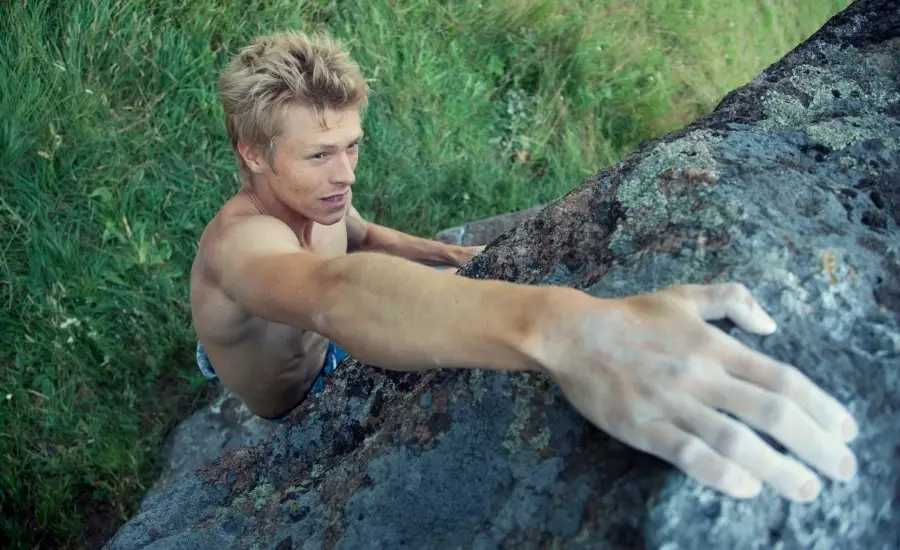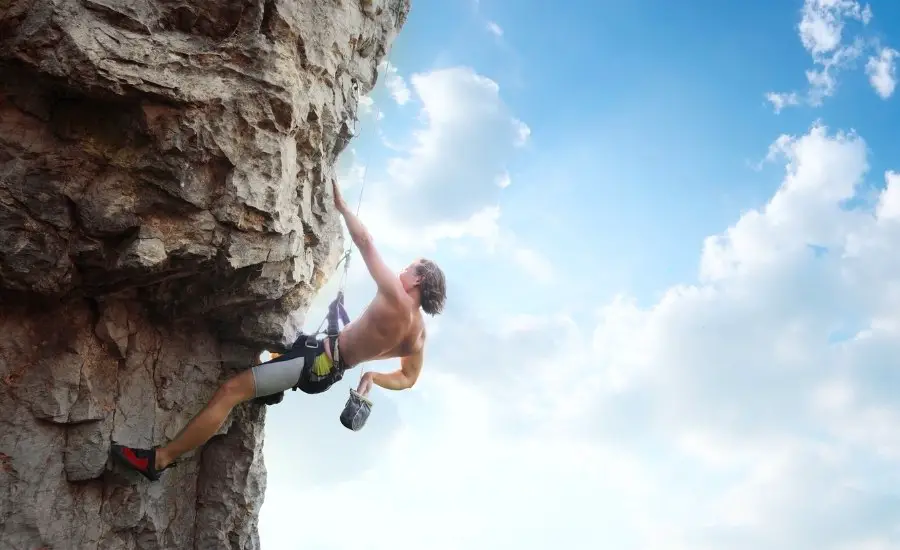A climber’s ape index greatly influences their climbing style and plays a big role in their overall climbing performance. Looking at the ape index of professional climbers will give us a clue as to what is a good ape index for climbing.
As a general rule, a good ape index for climbing is between +2.6 and +9.4 cm. On average, professional male climbers have a larger ape index than professional female climbers. The typical ape index for pro male climbers ranges between +3.6 and +10.4 cm and between +1.7 and +8.3 cm for pro female climbers.
While ape index plays a very important role in climbing, it does not directly determine if you will be a good climber or not. Famous climbers such as Adam Ondra have overcome having a small ape index by tailoring their climbing style towards their strengths. Continue on to see how you compare to 20 professional climbers.
If you are interested in seeing what the current prices are for the most popular rock climbing shoes, you can find them on Amazon by clicking here.
Statistical Analysis of 20 Professional Climber’s Ape Index

Professional climbers are the best of the best and shared physical characteristics between them likely contribute to their fantastic climbing ability. Looking at their ape index allows us to see if a specific ape index is preferred for climbing.
To establish if any trends are noticeable, we should first establish the average population’s ape index. The average ape index is about neutral (0 cm). This means the average person’s height will be the same length as their wingspan.
It should be noted that our analysis will be split between male and female climbers. This is because the average male’s ape index is larger than the average female’s according to the article linked here. We shall see if we notice this trend in the professional climbing population as well.
Personally, I stand at 181.5 cm tall and have a wingspan of 184 cm. This gives me an ape index of +2.5 cm (wingspan minus height). Lets see how I compare to various professional male climbers.

Ape Index of 10 Professional Male Climbers
I compiled a list of 10 male professional climbers and calculated their ape index. The table below details the results.
| Professional Climber | Height (cm) – Wingspan (cm) | Ape Index (cm) |
| Kai Harada | 169 – 180 | +11 |
| Jan Hojer | 188 – 198 | +10 |
| Tomoa Narasaki | 170 – 180 | +10 |
| Sascha Lehmann | 163 – 172 | +9 |
| Alex Honnold | 180 – 188 | +8 |
| Nathaniel Coleman | 180 – 188 | +8 |
| Jongwon Chon | 177 – 183 | +6 |
| Stefano Ghisolfi | 170 – 174 | +4 |
| Magnus Midtbø | 174 – 177 | +3 |
| Adam Ondra | 186 – 187 | +1 |
Doing some very brief statistical analysis we can see the average ape index of the analyzed professional male climbers is +7 cm with a standard deviation of 3.4 cm. Therefore:
The typical ape index for professional male climbers is between +3.6 and +10.4 cm.
rockclimbingguru.com
It should be noted that calculations derived from this will not be 100% accurate due to the small sample size. However, I believe the range given is reasonable as it is consistent with other studies conducted. An example of one such study can be seen linked here.
The study conducted by Artur Magiera was published in the Journal of Human Kinetics and titled “The structure of performance of a sport rock climber.” It analyzed characteristics of 30 advanced male sport climbers and found their average ape index to be positive as well (longer wingspan than height).

Ape Index of 10 Professional Female Climbers
I compiled a list of 10 female professional climbers and calculated their ape index. The table below details the results.
| Professional Climber | Height (cm) – Wingspan (cm) | Ape Index (cm) |
| Kyra Condie | 163 – 173 | +10 |
| Ashima Shiraishi | 154 – 164 | +10 |
| Shauna Coxsey | 163 – 171.5 | +8.5 |
| Alex Puccio | 157 – 162 | +5 |
| Emily Harrington | 157.5 – 162.5 | +5 |
| Rebecca Frangos | 150 – 155 | +5 |
| Emily Childress | 170 – 172.5 | +2.5 |
| Favia Dubyk | 159.5 – 162 | +2.5 |
| Brooke Raboutou | 158 – 160.5 | +2.5 |
| Indiana Chapman | 155 – 156 | +1 |
Doing some very brief statistical analysis we can see the average ape index of the analyzed professional female climbers is +5 cm with a standard deviation of 3.3 cm. Therefore:
The typical ape index for professional female climbers is between +1.7 and +8.3 cm.
rockclimbingguru.com
It should be noted that calculations derived from this will not be 100% accurate (as with the male climber analysis) due to the small sample size again. However, I believe the result of this analysis to be reasonable as well as it is consistent with other studies conducted.
Ape Index of all 20 Professional Climbers Analyzed

Using all 20 climber’s ape index, we can see:
The average ape index of professional climbers is +6 cm with a standard deviation of 3.4 cm. Therefore, the typical ape index for professional climbers is between +2.6 and +9.4 cm.
rockclimbingguru.com
The discrepancy between male and female ape index appears to have translated into the climbing world as well. While both groups have positive ape indexes, it was found that professional male climbers have slightly larger ape indexes than professional female climbers.
This is consistent with a study conducted by Christine Mermier published in the British Journal of Sports Medicine and titled “Physiological and anthropometric determinants of sport climbing performance”. The study analyzed the characteristics and performance of 44 climbers (24 male and 20 female) of various skill levels.
It found that male climbers had an ape index ratio (wingspan/height) between 1 and 1.08 while the female climbers had a ratio between 0.96 and 1.11. A ratio greater than 1 indicates the climber’s wingspan is greater than their height.
This study (seen linked here) is consistent with our analysis of the professional climbers. Both male and female climbers have a positive ape index; however, male climbers have a slightly larger ape index than females on average.

The Bottom Line
Professional climbers will typically have a positive ape index. Professional male climbers were seen to have a slightly larger ape index than professional female climbers. Although having a large ape index is not necessary to be a good climber, the evidence shows that most elite climbers do. To overcome a smaller ape index, climbers will have to play into their strengths and adopt different climbing techniques than climbers with long arms.
